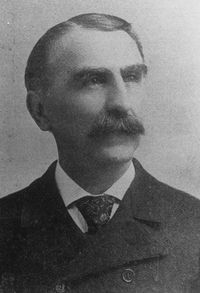Henry Gerhardt Sophus Baars (1844-1909) was a wealthy businessman who made his fortune in the lumber and shipping industries. He was the patriarch of the historically significant Baars family, whose vast land holdings shaped much of Pensacola's development.
| Henry Baars | |
|---|---|
| Born | February 29, 1844 Oldenburg Province, Germany |
| Died | July 2, 1909 Pensacola |
| Occupation | Lumber and shipping agent |
| Religion | Episcopalian |
| Spouse | Mary Ellison Baars |
| Parents | Ernest and H. Seibers Baars |
| Children | John Ernest Baars Theo Dunwody Baars Annie Ellison Baars Henry Gerhardt Baars Four others died in infancy |
Contents
Early lifeEdit
Born in Oldenburg Province in Northwestern Germany in 1844, Baars was the son of a prosperous lumberman and farmer. His father had intended for him to become heir to a landed fortune, but changed his plans when Kaiser William and Otto von Bismarck began formation of a large conscript army. To help his son avoid service in the army, the elder Baars purchased a military substitute for the boy, and arranged for Henry to take a small partnership with Carl Epping & Sons of London, a British timber trading company. In 1860, the firm sent Henry to their office in Savannah, Georgia.
Baars had barely arrived and begun his business career when the Civil War erupted. He enlisted in the Confederate Savannah Guards, was wounded twice in battle, and captured as a prisoner of war at Sailor's Creek in 1865. Returning to Georgia, he befriended an eight-year-old girl named Mary Ellison Dunwody, who was handing out small Confederate flags made by her mother.[1] They were married in 1871; he was 26, she was 16. He had managed to reopen the Epping office after the war, and in 1871 Baars elected to move to Pensacola, where prospects for lumbering and the timber trade seemed far better. Shortly thereafter Baars ended his association with the Epping company and began his own firm.
In PensacolaEdit
From 1871 forward, fortune smiled upon the Baars. They had eight children, four of whom survived infancy: John Earnest Baars, Theo Dunwody Baars, Annie Ellison Baars and Henry Gerhardt Baars. Baar's business enterprises soared; he was soon acting as agent for up to seventy-five lumber mills, shipping lumber to four continents and nearby islands. Baars was joined in the enterprise by his brother-in-law, Brian Dunwody, and later by his sons Theo and John Ernest. A second firm, Baars, Dunwody & Company, was formed to facilitate lumber exports, followed by a third, the Dunwody-Aiken Towing Company, to operate tug boats related to local shipping.
Baars also astute in recognizing that lumbering and the timber trade would come to an end, and he encouraged his sons and associates to begin planning other business interests. Their ventures into real estate and land development followed.
At the end of the Spanish-American War young Theo Baars took advantage of an opportunity and employed the foresight to acquire warrants issued to discharged service personnel. Those pieces of script were exchangeable for acreage on Northwest Florida's Perdido Key, a place totally unknown and thus unattractive to most discharged soldiers and sailors. From this effort, the Baars family acquired some 12,000 acres at minimal expense, which they held on to for almost seventy years, until the property had appeal for development.
Henry Baars continued operating his successful ventures until his death on July 2, 1909. He is buried in St. John's Cemetery.
Personal life & community serviceEdit
Throughout their married life, Henry and Mary Ellison Baars enjoyed a unique game. On gift giving occasions, he would ask her what she wanted, and she would respond: "Just buy me a piece of land." Baars did, and eventually Mary Ellison's holdings exceeded 6000 acres, all in the path of the city's growth. At one time, the Baars built a mansion on the city's perimeter. Mary Ellison intended to develop the surrounding area with vacation homes for wealthy northerners; however, the plan was scrapped when economic conditions soured, and the area was eventually developed as the Cordova Park neighborhood. They also owned a townhouse on East La Rua Street.
In September 1882 Baars was appointed vice-consul at Pensacola of the Austro-Hungarian Empire. He was awarded the Ritterkreuz (Knight's Cross) of the Order of Franz Joseph on November 3, 1908.
Baars was active in the community. He and Mary Ellison worked with others to fund the new Christ Church building, paid off its $25,000 mortgage in (date needed) and donated Tiffany windows to the church. A member of the Osceola Club and the Pensacola Chamber of Commerce, Baars strove to fund and build improvements in the downtown area. He and Mary Ellison were also patrons of the arts.
ReferencesEdit
- T. T. Wentworth, Jr. "Biographical Sketches of Early Citizens of Pensacola: Henry Gerhardt Sophus Baars." September 21, 1940.
- Pensacola Business Heritage in St. John's Historic Cemetery
- ↑ "Baars Meant Serious Business With City's Early Development." Pensacola News, March 7-11, 1983.
